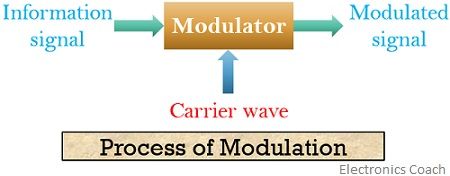The major difference between modulation and demodulation is that modulation is the act of altering the parameters of the carrier signal according to message signal for convenient data transmission. On the contrary, demodulation is done in order to recover the original message signal from a modulated signal.
Another crucial difference between modulation and demodulation is that modulation is done at the transmitting end while demodulation occurs at the receiving end.
Both modulation and demodulation are reversal processes of each other. Thus, is done at the two ends of a communication system. Before procedding further, just have a look at the contents which we will be going to discuss under this article.
Content: Modulation Vs Demodulation
Comparison Chart
| Parameter | Modulation | Demodulation |
|---|---|---|
| Definition | Modulation is the process of varying the parameter of the carrier signal according to message bearing signal. | Demodulation is the process by which message signal is extracted from the modulated wave. |
| Operating end | Transmitting end | Receiving end |
| Operation | Simple | Complex |
| Frequency transformation | Low to high | High to low |
| Circuit needed | Modulator | Demodulator/Detector |
Definition of Modulation
Modulation is the process by which some characteristics or parameters of the carrier wave is changed according to the signal containing information. These characteristics can be amplitude, frequency or phase. Basically, it is assumed that the information signal is a low-frequency one and thus needs conversion from low to high in order to have a better transmission.
Now the thing that strikes our mind is how to achieve this, and the answer is with the carrier wave.
What is a carrier wave?
A carrier wave is a high-frequency signal that has constant amplitude and frequency and is generated from a radio frequency oscillator. These are used to modulate the original signal that contains information and has to be transmitted. It is sometimes referred to as an empty signal as it is an informationless signal.
Simply transmitting a baseband signal (message signal) to longer distances causes various unwanted alterations in the signal itself. There exist several unwanted parameters that unknowingly causes variation in the message signal. Thus, to avoid this, modulation is performed.
Let us have a look at the diagrammatic representation of the process of modulation shown below

Here as we can see that message signal also known as modulating signal is fed to the modulator. At the same time, a high-frequency carrier signal is also applied to the modulator whose characteristics are to be varied. Resultantly, a modulated signal is achieved at the output of the modulator. This modulated signal is transmitted further to any certain distance.
Definition of Demodulation
Demodulation is the process by which receiver regain the original message signal from the modulated one. As the name itself is indicating that ‘de’ placed before modulation in demodulation is the reverse of modulation.
As we have already discussed that modulating a signal is very useful as it allows us to have proper and long-distance signal transmission. At the same time demodulation is also necessary in order to recover the particular message signal.
This is so because the receiver does not want a modulated signal as its desired signal thus for the separation of modulating signal from the carrier wave demodulation is done at the receiver section.
When we talk about a demodulator that is responsible for demodulation then it is predefined that it is placed at the receiving end, according to its use. It basically receives the corrupted data whether it is in bits format or a sound signal. This high frequency modulated signal is then processed further by this section to get the actual information-bearing signal.
There exist several techniques by which demodulation can be achieved. A modem is a device that is used for modulation and demodulation both. Hence modem is the name derived from modulator and demodulator. Several techniques are used for the process of modulation and demodulation whose implementation depends on the area of need. Along with this various advantages and disadvantages are associated with different detection methods.
Key Differences Between Modulation and Demodulation
- The key difference between modulation and demodulation is that modulation is done at the transmitter side while demodulation is done at the receiver side of a communication system.
- Both modulation and demodulation occur during data transmission but the two processes are exactly reverse of each other. In modulation original message signal is mixed with the carrier wave whose parameters are required to be changed. As against, in demodulation the combination of carrier and message signal are separated from each other, to have original information signal.
- Modulation requires a modulator section for mixing of the two signals whereas demodulation requires demodulator to recover the original signal. However, a combined equipment is used for the two known as Modem.
- Modulation is done to convert the low-frequency signal into a high-frequency signal. While at the time of demodulation, the low-frequency signal is achieved form high-frequency signal.
- Modulation is basically done to transmit data to longer distance whereas demodulation is done to regain the original message signal.
- Demodulation is somewhat a complex process when compared with modulation.
Conclusion
Both modulation and demodulation are the important processes involved in a communication system but their reverse operation differentiates the two. It is noteworthy here that, the two processes must be compatible with each other in order to have appropriate data transmission and reception.
Leave a Reply